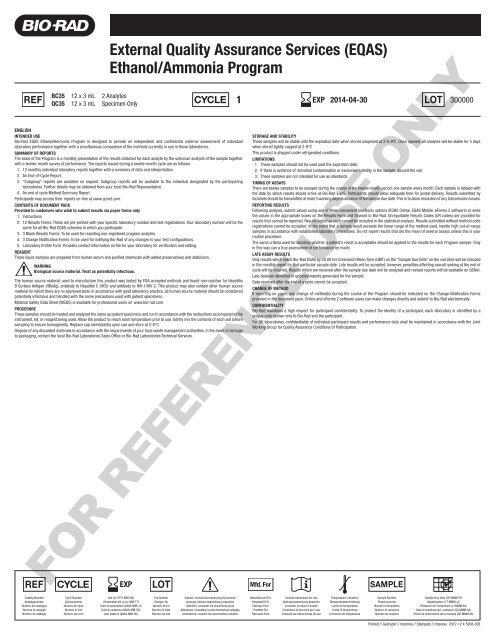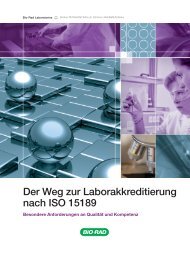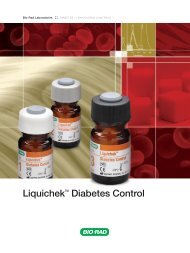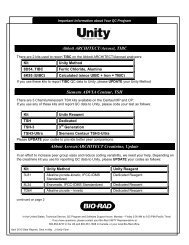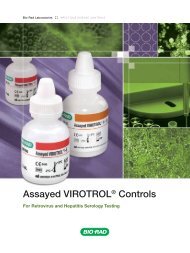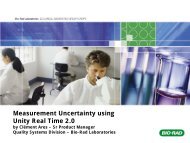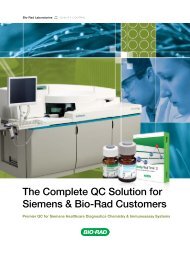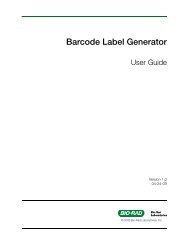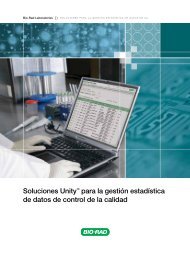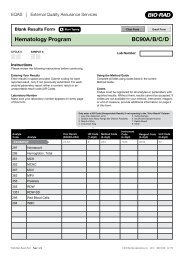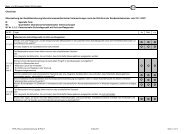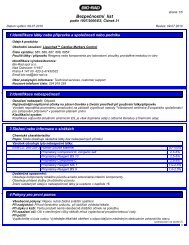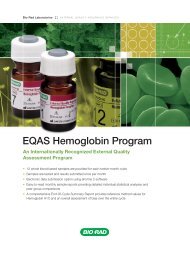Ethanol/Ammonia Program - QCNet
Ethanol/Ammonia Program - QCNet
Ethanol/Ammonia Program - QCNet
You also want an ePaper? Increase the reach of your titles
YUMPU automatically turns print PDFs into web optimized ePapers that Google loves.
External Quality Assurance Services (EQAS)<strong>Ethanol</strong>/<strong>Ammonia</strong> <strong>Program</strong>BC35 12 x 3 mL 2 AnalytesQC35 12 x 3 mL Specimen Only1EXP 2014-04-30 300000ENGLISHINTENDED USEBio-Rad EQAS <strong>Ethanol</strong>/<strong>Ammonia</strong> <strong>Program</strong> is designed to provide an independent and confidential external assessment of individuallaboratory performance together with a simultaneous comparison of the methods currently in use in those laboratories.SUMMARY OF REPORTSThe basis of the <strong>Program</strong> is a monthly presentation of the results obtained for each analyte by the unknown analysis of the sample togetherwith a twelve-month survey of performance. The reports issued during a twelve-month cycle are as follows:1. 12 monthly individual laboratory reports together with a summary of data and interpretation.2. An End-of-Cycle Report.3. “Subgroup” reports are available on request. Subgroup reports will be available to the individual designated by the participatinglaboratories. Further details may be obtained from your local Bio-Rad Representative.4. An end of cycle Method Summary Report.Participants may access their reports on-line at www.qcnet.com.CONTENTS OF DOCUMENT PACKProvided to customers who wish to submit results via paper forms only1. Instructions2. 12 Results Forms: These are pre-printed with your specific laboratory number and test registrations. Your laboratory number will be thesame for all Bio-Rad EQAS schemes in which you participate.3. 3 Blank Results Forms: To be used for reporting non-registered program analytes.4. 3 Change Notification Forms: To be used for notifying Bio-Rad of any changes to your test configurations.5. Laboratory Profile Form: Provides contact information on file for your laboratory for verification and editing.REAGENTThese liquid samples are prepared from human serum and purified chemicals with added preservatives and stabilizers.WARNINGBiological source material. Treat as potentially infectious.The human source material used to manufacture this product was tested by FDA accepted methods and found non-reactive for HepatitisB Surface Antigen (HBsAg), antibody to Hepatitis C (HCV) and antibody to HIV-1/HIV-2. This product may also contain other human sourcematerial for which there are no approved tests. In accordance with good laboratory practice, all human source material should be consideredpotentially infectious and handled with the same precautions used with patient specimens.Material Safety Data Sheet (MSDS) is available for professional users on www.bio-rad.com.PROCEDUREThese samples should be treated and analyzed the same as patient specimens and run in accordance with the instructions accompanying theinstrument, kit, or reagent being used. Allow the product to reach room temperature prior to use. Gently mix the contents of each vial beforesampling to ensure homogeneity. Replace cap immediately upon use and store at 2-8°C.Dispose of any discarded materials in accordance with the requirements of your local waste management authorities. In the event of damageto packaging, contact the local Bio-Rad Laboratories Sales Office or Bio-Rad Laboratories Technical Services.STORAGE AND STABILITYThese samples will be stable until the expiration date when stored unopened at 2 to 8ºC. Once opened, all analytes will be stable for 5 dayswhen stored tightly capped at 2-8°CThis product is shipped under refrigerated conditions.LIMITATIONS1. These samples should not be used past the expiration date.2. If there is evidence of microbial contamination or excessive turbidity in the sample, discard the vial.3. These samples are not intended for use as standards.TIMING OF ASSAYSThere are twelve samples to be assayed during the course of the twelve-month period, one sample every month. Each sample is labeled withthe date by which results should arrive at Bio-Rad EQAS. Participants should allow adequate time for postal delivery. Results submitted byfacsimile should be transmitted at least 3 working days in advance of the sample due date. This is to allow resolution of any transmission issues.REPORTING RESULTSFollowing analysis, submit values using one of three convenient electronic options (EQAS Online, EQAS Mobile, eForms 2 software) or writethe values in the appropriate boxes on the Results Form and forward to Bio-Rad. Unreportable Results Codes (UR codes) are provided forresults that cannot be reported. Results coded as such cannot be included in the statistical analysis. Results submitted without method coderegistrations cannot be accepted. In the event that a sample result exceeds the linear range of the method used, handle high out-of-rangesamples in accordance with established laboratory procedures. Do not report results that are the mean of several assays unless this is yourroutine procedure.The same criteria used for deciding whether a patient’s result is acceptable should be applied to the results for each <strong>Program</strong> sample. Onlyin this way can a true assessment of performance be made.LATE ASSAY RESULTSOnly results which reach Bio-Rad EQAS by 20:00 hrs Greenwich Mean Time (GMT) on the “Sample Due Date” on the vial label will be includedin the monthly report for that particular sample date. Late results will be accepted, however, penalities affecting overall ranking at the end ofcycle will be incurred. Results which are received after the sample due date will be analyzed and revised reports will be available on <strong>QCNet</strong>.Late data are identified in updated reports generated for the sample.Data received after the end of a cycle cannot be accepted.CHANGE OF METHODIf reporting on paper, any change of method(s) during the course of the <strong>Program</strong> should be indicated on the Change Notification Formsprovided in the document pack. Online and eForms 2 software users can make changes directly and submit to Bio-Rad electronically.CONFIDENTIALITYBio-Rad maintains a high respect for participant confidentiality. To protect the identity of a participant, each laboratory is identified by aunique code known only to Bio-Rad and the participant.For UK laboratories, confidentiality of individual participant results and performance data shall be maintained in accordance with the JointWorking Group for Quality Assurance Conditions of Participation.EXPCatalog NumberKatalognummerNuméro de catalogueNumero di catalogoNúmero de catálogoCycle NumberZyklusnummerNuméro de cycleNumero di cicliNúmero del cicloUse by (YYYY-MM-DD)Verwendbar bis (JJJJ-MM-TT)Date de péremption (AAAA-MM-JJ)Data di scadenza (AAAA-MM-GG)Usar hasta el (AAAA-MM-DD)Lot NumberChargen-Nr.Numéro de lotNumero di lottoNúmero de loteCaution, Consult Accompanying DocumentsAchtung, Gebrauchsanweisung beachtenAttention, consulter les documents jointsAttenzione, consultare la documentazione allegataAdvertencia, consulte los documentos incluidosManufactured ForHergestellt FürFabriqué PourProdotto PerFabricado ParaConsult Instructions for UseGebrauchsanweisung beachtenConsulter la notice d’emploiConsultare le istruzioni per l’usoConsulte las instrucciones de usoTemperature LimitationTemperaturbeschränkungLimite de températureLimite di temperaturaLimitación de temperaturaSample NumberProbennummerNuméro d’échantillonNumero di campioneNúmero de muestraSample Due Date (DD MMM YY)Abgabedatum (TT MMM JJ)Échéance de l’échantillon (JJ MMM AA)Data di scadenza per i campioni (GG MMM AA)Fecha de vencimiento de la muestra (DD MMM AA)
EQAS <strong>Ethanol</strong>/<strong>Ammonia</strong> <strong>Program</strong>DEUTSCHVERWENDUNGSZWECKDas Bio-Rad EQAS <strong>Ethanol</strong>/<strong>Ammonia</strong> <strong>Program</strong> ist ein externer und unabhängiger Laborvergleich, der es dem teilnehmenden Labor erlaubt,die angewendeten Methoden und die individuelle Leistungsfähigkeit mit anderen Laboratorien zu vergleichen.ZUSAMMENFASSUNG DER REPORTSDas <strong>Program</strong>m umfasst verschiedene Reports, anhand derer die Leistungsfähigkeit des Labors beurteilt werden kann, u. a. den Basis-Report,der monatlich die Ergebnisse für alle untersuchten Analyte der unbekannten Proben beurteilt. Nach 12 Monaten, am Ende eines Zyklus, wirdein umfassender Zyklus-Report erstellt. Folgende Reports werden im Laufe eines Zyklus von 12 Monaten erstellt:1. Zwölf individuelle Labor-Reports, monatlich, mit einer Zusammenfassung und der Interpretation der Ergebnisse.2. Report am Zyklusende.3. „Untergruppen“-Reports sind auf Anfrage erhältlich. Untergruppen-Reports können vom Organisator auf Wunsch eines Teilnehmersindividuell zur Verfügung gestellt werden. Weiterführende Informationen erhalten Sie von Ihrer Bio-Rad-Niederlassung.4. Methodenübersichtsreport am Zyklusende.Die Reports können von den Teilnehmern online unter www.qcnet.com/de abgerufen werden.INHALT DER DOKUMENTENPACKSFür Kunden, die Ergebnisse nur in Papierform einreichen möchten1. Anleitung2. 12 Ergebnisformblätter: Auf diesen sind bereits Ihre spezifische Labornummer und Testregistrierungen angegeben. Die Labornummerist für alle Bio-Rad EQAS-<strong>Program</strong>me, an denen Sie teilnehmen, identisch.3. 3 auszufüllende Ergebnisformblätter: Zur Meldung von nicht registrierten <strong>Program</strong>m-Analyten.4. 3 Formblätter zur Änderung von Methoden: Zur Benachrichtigung von Bio-Rad über etwaige Änderungen Ihrer Testkonfigurationen.5. Formblatt zum Laborprofil: Enthält die vorliegenden Kontaktinformationen für Ihr Labor zur Überprüfung und Bearbeitung.REAGENZDiese flüssigen Proben wurden aus Humanserum mit gereinigten Chemikalien hergestellt und enthalten Zusätze von Konservierungsmittelnund Stabilisatoren.WARNUNGMaterial biologischer Herkunft. Als potenziell infektiös zu behandeln.Die zur Herstellung dieses Produkts verwendeten Materialien humanen Ursprungs wurden mit von der amerikanischen ArzneimittelbehördeFDA (Food and Drug Administration) zugelassenen Methoden getestet und als nicht-reaktiv bezüglich Hepatitis-B-Oberflächen-Antigen(HBsAg), Antikörpern gegen Hepatitis C (HCV) und Antikörpern gegen HIV-1/HIV-2 befunden. Das Produkt enthält unter Umständen andereBestandteile menschlichen Ursprungs, für die keine zugelassenen Testverfahren existieren. In Übereinstimmung mit den Richtlinien derguten Laborpraxis sollten alle Materialien menschlichen Ursprungs als potenziell infektiös betrachtet und mit der gleichen Sorgfalt wiePatientenproben behandelt werden.Sicherheitsdatenblätter (MSDS) stehen Ihnen im Internet unter www.bio-rad.com zur Verfügung.HANDHABUNGDiese Proben sind genau wie Patientenproben zu behandeln und zu analysieren und in Übereinstimmung mit den Vorschriften des Geräte-,Kit-, oder Reagenzherstellers anzuwenden. Das Produkt vor Gebrauch Raumtemperatur erreichen lassen. Vor Entnahme einer Probeden Inhalt jedes Fläschchens vorsichtig durchmischen, um die Homogenität sicherzustellen. Fläschchen nach Gebrauch sofort wiederverschließen und bei 2–8 °C lagern.Die Entsorgung aller Abfälle ist nach den geltenden örtlichen Bestimmungen vorzunehmen. Falls die Verpackung beschädigt ist, nehmen Siebitte Kontakt zur Bio-Rad-Niederlassung auf.LAGERUNG UND HALTBARKEITDiese Proben sind bis zum angegebenen Haltbarkeitsdatum stabil, wenn sie ungeöffnet bei 2–8 °C gelagert werden. Nach dem Öffnen sindalle Analyte 5 Tage stabil, sofern die Fläschchen dicht verschlossen bei 2–8 °C aufbewahrt werden.Dieses Produkt wird gekühlt versandt.EINSCHRÄNKUNGEN1. Diese Proben nach Ablauf des Haltbarkeitsdatums nicht mehr verwenden.2. Bei Anzeichen einer mikrobiellen Kontamination oder einer starken Trübung der Probe ist das Fläschchen zu verwerfen.3. Diese Proben sind nicht zur Verwendung als Standard geeignet.ZEITPUNKT DER ANALYSENIm Zeitraum von zwölf Monaten sind zwölf Proben zu bestimmen: jeden Monat eine Probe. Auf jeder Probe ist ein Datum angegeben; zudiesem Fälligkeitsdatum müssen die Ergebnisse bei Bio-Rad EQAS eingetroffen sein. Die Teilnehmer sollten beim Postversand die Dauerder Postwege einkalkulieren. Ergebnisse, die per Fax übermittelt werden, sollten mindestens 3 Arbeitstage vor dem Abgabedatum gefaxtwerden. Dadurch besteht die Möglichkeit der Rückfrage, wenn die Übermittlung in schlechter Qualität erfolgte oder die Faxe unlesbar sind.ÜBERMITTLUNG DER ANALYSENERGEBNISSENach der Analyse sind die erzielten Werte mit einer von drei elektronischen Methoden (EQAS Online, EQAS Mobile, eForms 2-Software) zuübermitteln oder in die entsprechenden Felder des Ergebnisformblatts einzutragen und an Bio-Rad zu senden. Für Ergebnisse, die nichtübermittelt werden können, stehen spezielle UR-Codes (UR = Unreportable Results) zur Verfügung. Auf diese Weise codierte Ergebnissekönnen bei der statistischen Analyse nicht berücksichtigt werden. Eingereichte Ergebnisse ohne registrierten Methodencode können nichtakzeptiert werden. Falls ein Analysenergebnis den linearen Bereich des verwendeten Verfahrens übersteigt, ist die Probe in Übereinstimmungmit dem etablierten Laborverfahren zu handhaben. Es sollten keine Mittelwerte mehrerer Einzelmessungen übermittelt werden, es sei denn,dies ist Ihre übliche Vorgehensweise.Für die Beurteilung der Ergebnisse von Kontrollproben sollten die gleichen Kriterien angelegt werden, nach denen beurteilt wird, ob einPatientenergebnis freigegeben werden kann. Nur so kann die Leistungsfähigkeit des Teilnehmers optimal beurteilt werden.VERSPÄTETE ANALYSENERGEBNISSEDie Ergebnisse müssen bis 20:00 Uhr – Greenwich Zeit (GMT) – an dem auf dem Fläschchenetikett angegebenen Probenfälligkeitsdatum beiBio-Rad EQAS eingetroffen sein, um im monatlichen Report für das jeweilige Probendatum berücksichtigt zu werden. Verspätete Ergebnissewerden angenommen, es werden jedoch Punkte in der Gesamtbewertung am Ende des Zyklus abgezogen. Ergebnisse, die nach demFälligkeitsdatum eingehen, werden analysiert; revidierte Reports sind über <strong>QCNet</strong> erhältlich.Nachträglich eingereichte Daten werden in den für die Probe erstellten aktualisierten Reports gekennzeichnet.Analysenergebnisse, die nach Zyklusende eingehen, können nicht ausgewertet werden.METHODENÄNDERUNGBei der Ergebniseinreichung in Papierform sollte Bio-Rad EQAS umgehend von einer Methodenänderung innerhalb des laufenden <strong>Program</strong>msunterrichtet werden. Dazu ist das Formblatt zur Änderung von Methoden aus dem Dokumentenpack zu verwenden. Anwender von Online- undeForms 2-Software können die Änderungen direkt eingeben und elektronisch an Bio-Rad senden.VERTRAULICHKEITBio-Rad behandelt die Daten der Teilnehmer mit größter Vertraulichkeit. Um die Identität der Teilnehmer zu schützen, wird jedem Labor einspezifischer Code zugeteilt, der nur Bio-Rad und dem teilnehmenden Labor bekannt ist.FRANÇAISUTILISATIONLe Bio-Rad EQAS <strong>Ethanol</strong>/<strong>Ammonia</strong> <strong>Program</strong> est conçu pour permettre une évaluation externe, indépendante et confidentielle des résultatsde différents laboratoires ainsi qu’une comparaison simultanée des méthodes actuellement utilisées dans ces laboratoires.RECAPITULATIF DES RAPPORTSLe programme est basé sur une présentation mensuelle des résultats obtenus pour chaque analyte d’un échantillon avec une étude desperformances sur douze mois. Les rapports émis pendant un cycle de douze mois comprennent :1. 12 rapports mensuels de chaque laboratoire avec un récapitulatif des données et leur interprétation.2. Un rapport de fin de cycle.3. Des rapports de « sous-groupes » sont disponibles sur demande. Les rapports de sous-groupes seront mis à la disposition de lapersonne nommée par les laboratoires participants. Des renseignements détaillés peuvent être obtenus auprès de votre représentantBio-Rad local.4. Un rapport récapitulatif de méthode en fin de cycle.Les participants peuvent accéder à leurs rapports en ligne sur www.qcnet.com.CONTENU DE LA POCHETTE DE DOCUMENTSFournie aux clients qui souhaitent envoyer les résultats sur papier uniquement1. Instructions2. 12 formulaires de résultats : ils sont pré-imprimés avec le numéro de code de votre laboratoire et vos enregistrements de test. Lenuméro de code du laboratoire reste le même pour tous les programmes EQAS de Bio-Rad auxquels le laboratoire participe.3. 3 formulaires de résultats vierges : à utiliser pour signaler les analytes non enregistrés du programme.4. 3 formulaires de notification de modification : à utiliser pour avertir Bio-Rad des modifications apportées aux configurations de test.5. Formulaire de profil de laboratoire : fournit les coordonnées du laboratoire enregistrées dans la base de données, à des fins devérification et modification.REACTIFCes échantillons liquides sont préparés à partir de sérum humain et de produits chimiques purifiés auxquels ont été ajoutés des agentsconservateurs et des stabilisants.ATTENTIONProduit d’origine biologique. À considérer comme potentiellement infectieux.Les substances d’origine humaine utilisées dans la préparation de ce produit ont été analysées à l’aide de méthodes approuvées parla FDA (Food and Drug Administration, U.S.A.) et ont présenté des résultats négatifs pour l’antigène de surface de l’hépatite B (AgHBs)et les anticorps de l’hépatite C (VHC) et du VIH-1/VIH-2. Il est possible que ce produit contienne d’autres substances d’origine humainepour lesquelles il n’existe pas de test agréé. Conformément aux bonnes pratiques de laboratoire, toute substance d’origine humaine doitêtre considérée comme potentiellement infectieuse et manipulée avec les mêmes précautions que les échantillons provenant de patients.Une fiche de sécurité (MSDS) est à disposition des utilisateurs professionnels sur le site www.bio-rad.com.MODE OPERATOIRECes échantillons doivent être traités et analysés comme les échantillons de patients, en respectant les instructions accompagnant l’appareil,le kit ou le réactif utilisé. Amener le produit à la température ambiante avant de l’utiliser. Homogénéiser en mélangeant le contenu de chaqueflacon avant utilisation. Reboucher immédiatement après utilisation et conserver entre 2 et 8 °C.Tout déchet doit être éliminé conformément aux réglementations locales relatives au traitement des déchets. Si le conditionnement estendommagé, contacter le bureau des ventes ou le service technique local de Bio-Rad Laboratories.CONSERVATION ET STABILITECes échantillons restent stables jusqu’à la date de péremption lorsque le produit est conservé non ouvert entre 2 et 8 °C. Une fois le produitouvert, tous les analytes restent stables pendant 5 jours en flacon convenablement fermé et conservé entre 2 et 8 °C.Ce produit est expédié réfrigéré.LIMITES1. Ne pas utiliser ces échantillons après la date de péremption.2. En cas de contamination microbienne ou de trouble excessif de l’échantillon, éliminer le flacon.3. Ces échantillons ne sont pas conçus pour être utilisés comme étalons.FREQUENCE DES DOSAGESDouze échantillons doivent être analysés au cours d’un cycle de douze mois, à raison d’un échantillon par mois. Chaque échantillon estétiqueté avec la date à laquelle les résultats doivent parvenir à Bio-Rad EQAS. Les participants doivent prévoir un délai suffisant pourl’expédition par voie postale. Les résultats envoyés par télécopie doivent être transmis au moins trois jours ouvrables avant l’échéance del’échantillon afin de permettre la résolution des problèmes éventuels de transmission.RAPPORTS DE RESULTATSAprès l’analyse, envoyer les valeurs par l’un des trois moyens électroniques pratiques proposés (EQAS en ligne, EQAS Mobile, logicieleForms 2) ou les consigner dans les cases appropriées du formulaire de résultats et les transmettre à Bio-Rad. Des codes de résultats nonrapportables (codes UR) sont fournis pour les résultats qui ne peuvent pas être communiqués. Les résultats codés non rapportables nepeuvent pas être inclus dans l’analyse statistique. Les résultats envoyés sans enregistrement de code de méthode ne pourront être acceptés.Si le résultat d’un échantillon dépasse la plage linéaire de la méthode utilisée, traiter les échantillons hors plage élevés selon les procéduresétablies par le laboratoire. Ne pas indiquer de résultats qui constituent la moyenne de plusieurs dosages sauf si cette procédure est utiliséecouramment dans le laboratoire.Les critères appliqués aux échantillons du programme seront les mêmes que ceux utilisés pour décider si le résultat d’un patient estacceptable. C’est la condition indispensable à une évaluation correcte des performances.RESULTATS EN RETARDSeuls les résultats parvenus à Bio-Rad EQAS avant 20 h 00 (temps universel de Greenwich) à « l’échéance de l’échantillon » (date indiquéeen regard de « Sample Due Date » sur l’étiquette du flacon) seront intégrés dans le rapport mensuel pour cette date d’échantillon. Lesrésultats en retard seront acceptés. Toutefois, des pénalités affectant le classement en fin de cycle seront attribuées. Les résultats reçusaprès l’échéance de l’échantillon seront analysés et des rapports révisés seront disponibles sur <strong>QCNet</strong>.Les données soumises en retard sont indiquées dans les rapports actualisés générés pour l’échantillon.Les données reçues après la fin d’un cycle ne peuvent pas être acceptées.CHANGEMENT DE METHODESi les résultats sont communiqués sur papier, tout changement de méthode(s) pendant la durée du programme doit être indiqué dans lesformulaires de notification de modification fournis dans la pochette de documents. Les utilisateurs d’EQAS en ligne et du logiciel eForms 2peuvent procéder directement à des changements et les communiquer par voie électronique à Bio-Rad.CONFIDENTIALITEBio-Rad respecte strictement la confidentialité et l’identité des participants. Par souci de protection, chaque laboratoire est identifié par uncode unique, connu uniquement de Bio-Rad et du participant.
EQAS <strong>Ethanol</strong>/<strong>Ammonia</strong> <strong>Program</strong>ITALIANOUSO PREVISTOBio-Rad EQAS <strong>Ethanol</strong>/<strong>Ammonia</strong> <strong>Program</strong> è un programma formulato per fornire una valutazione esterna indipendente e confidenziale delleprestazioni dei singoli laboratori e un confronto simultaneo dei metodi attualmente in uso in quei laboratori.RIASSUNTO DEI REPORTIl programma prevede un dosaggio mensile su campioni non noti e l’elaborazione annuale dei risultati ottenuti per ogni analita. I reportprodotti durante un ciclo di 12 mesi sono i seguenti.1. 12 report mensili del singolo laboratorio e un riepilogo dei dati con relativa interpretazione.2. Un report di fine ciclo.3. Su richiesta sono disponibili dei report per “laboratori affiliati”. I report per laboratori affiliati saranno resi disponibili per la personadesignata dai laboratori partecipanti. Ulteriori informazioni possono essere ottenute dal rappresentante Bio-Rad locale.4. Un report riepilogativo sui metodi di fine ciclo.I partecipanti hanno la possibilità di accedere on-line ai loro report all’indirizzo web www.qcnet.it.CONTENUTO DEL “DOCUMENT PACK”Fornito solo ai clienti che desiderano inviare i risultati utilizzando moduli cartacei1. Istruzioni2. 12 moduli per i risultati (Result Form): questi moduli sono prestampati con il codice del laboratorio assegnato e con i test eseguiti eregistrati a questo programma. Il numero del laboratorio rimarrà lo stesso per tutti i programmi Bio-Rad EQAS a cui l’utente partecipa.3. 3 moduli “in bianco” per i risultati (Blank Results Form): da usare per riportare gli analiti non ancora registrati al programma.4. 3 moduli di variazione (Change Notification Form): da usare per avvertire Bio-Rad di qualsiasi modifica apportata alle configurazioni dei test.5. Il modulo del profilo del laboratorio (Laboratory Profile Form): fornisce le informazioni presenti in archivio sui contatti relativi allaboratorio, per verificare l’esattezza delle informazioni che sono in nostro possesso.REAGENTEQuesti campioni liquidi sono preparati con siero umano e sostanze chimiche purificate, con aggiunta di conservanti e stabilizzanti.AVVERTENZAMateriale di origine biologica. Trattare come potenzialmente infettivo.Il materiale di origine umana utilizzato per preparare questo prodotto è stato testato mediante metodi approvati dalla FDA e risultato nonreattivo per l’antigene di superficie dell’epatite B (HBsAg), l’anticorpo contro l’epatite C (HCV) e l’anticorpo contro l’HIV-1/HIV-2. Questoprodotto può anche contenere altro materiale di origine umana per il quale non esistono procedure di dosaggio approvate. Secondo le buonepratiche di laboratorio, tutti i materiali di origine umana devono essere considerati potenzialmente infettivi, perciò si raccomanda di trattarequesto prodotto con le medesime precauzioni adottate per i campioni dei pazienti.Scheda informativa sulla sicurezza del materiale (MSDS) ad uso professionale disponibile al sito www.bio-rad.it.PROCEDURAQuesti campioni devono essere trattati e analizzati allo stesso modo dei campioni in esame ed usati secondo le istruzioni che accompagnanolo strumento, il kit o il reagente in uso. Riportare il prodotto a temperatura ambiente prima dell’uso. Prima del campionamento, miscelaredelicatamente il contenuto di ciascun flacone al fine di assicurarne l’omogeneità. Dopo l’uso, rimettere immediatamente il tappo e conservarea 2-8 °C.Eliminare eventuali materiali residui nel rispetto delle norme locali sullo smaltimento dei rifiuti. Nel caso di danni alla confezione, contattaregli uffici Bio-Rad o l’agente di zona.CONSERVAZIONE E STABILITÀQuesti campioni sono stabili fino alla data di scadenza quando vengono conservati, non aperti, a 2-8 °C. Una volta aperto il prodotto, tutti glianaliti sono stabili per 5 giorni quando il prodotto è conservato ben chiuso a 2-8 °C.Il prodotto viene spedito refrigerato.LIMITI1. Non usare questi campioni dopo la data di scadenza.2. In caso di evidente contaminazione microbica o di eccessiva torbidezza nel campione, eliminare il flacone.3. Questi campioni non sono concepiti per l’uso come standard di riferimento.TEMPI DEI DOSAGGIDurante il periodo di 12 mesi verranno analizzati dodici campioni, ovvero un campione al mese. Ogni campione è etichettato con la data entrola quale i risultati devono giungere al Bio-Rad EQAS Centre. Se si inviano i risultati per posta, spedirli con un certo anticipo. I dati inviati viafax dovrebbero essere trasmessi almeno 3 giorni lavorativi prima della data di scadenza per i campioni, in modo da poter risolvere eventualiproblemi di trasmissione.REFERTAZIONE DEI RISULTATIDopo l’analisi, inserire i valori usando una delle tre comode opzioni elettroniche (EQAS Online, EQAS Mobile, software eForms 2), oppuretrascrivere i valori nelle relative caselle del modulo Results Form e inoltrarli a Bio-Rad. Per i risultati che non possono essere refertati,vengono forniti codici dei risultati non refertabili (Unreportable Results Codes, o codici UR). I risultati riportanti tali codici non possono essereinclusi nell’analisi statistica. I risultati inviati senza registrazioni dei codici metodologici non possono essere accettati. Nel caso che il risultatodi un campione superi l’intervallo lineare del metodo usato, trattare i campioni fuori intervallo secondo le procedure stabilite nel laboratorio.Non refertare risultati che rappresentino la media di diverse analisi a meno che questa non sia la procedura di routine.Gli stessi criteri usati per decidere se un valore di un paziente deve essere considerato accettabile dovrebbero essere applicati ai risultatiottenuti su tutti i campioni del programma. Solo in questo modo è possibile ottenere un reale riscontro delle prestazioni del proprio sistemadi qualità.RISULTATI DI DOSAGGI IN RITARDOSolo i risultati che giungono al Bio-Rad EQAS entro le ore 20.00 (GMT, ora del meridiano di Greenwich) della “Data di scadenza per i campioni”stampata sull’etichetta del flacone, verranno inclusi nel report mensile per quella particolare data. I risultati in ritardo verranno accettati, ma laposizione del laboratorio nella classifica generale del report di fine ciclo sarà penalizzata. I risultati ricevuti dopo la data di scadenza sarannoanalizzati e report modificati saranno disponibili su <strong>QCNet</strong>.Nel report del campione successivo sono identificabili eventuali dati in ritardo.I dati ricevuti dopo la conclusione di un ciclo non potranno essere accettati.MODIFICA DI METODOSe si refertano i risultati utilizzando la modalità cartacea, qualsiasi modifica di metodo(i) durante il programma in corso deve essere indicatanei “Moduli di variazione” (Change Notification Forms) forniti con la documentazione. Gli utenti online e del software eForms 2 possonoapportare direttamente i cambiamenti e inviarli a Bio-Rad elettronicamente.RISERVATEZZABio-Rad garantisce un elevato rispetto della riservatezza dei dati dei partecipanti. Per proteggere l’identità di un partecipante, ogni laboratorioè identificato da un codice univoco noto esclusivamente a Bio-Rad e al partecipante.ESPAÑOLUSO INTENCIONADOBio-Rad EQAS <strong>Ethanol</strong>/<strong>Ammonia</strong> <strong>Program</strong> ha sido diseñado para proporcionar una evaluación externa independiente y confidencial delfuncionamiento de laboratorios concretos, junto con la comparación simultánea de los métodos actualmente en uso en esos laboratorios.RESUMEN DE INFORMESEl programa se basa en una presentación mensual de los resultados obtenidos para cada analito mediante el análisis desconocido de lamuestra, junto con un estudio del funcionamiento de doce meses de duración. En el ciclo de doce meses se elaboran los siguientes informes:1. Doce informes mensuales de cada laboratorio, junto con un resumen de los datos y su interpretación.2. Un informe de fin de ciclo.3. Informes de “subgrupos”, disponibles a petición del cliente. Los informes de subgrupos estarán disponibles para las personas indicadaspor los laboratorios participantes. Para obtener más detalles, consulte con el representante local de Bio-Rad.4. Un informe de resumen de métodos de fin de ciclo.Los participantes pueden acceder a sus informes on line en www.qcnet.com.CONTENIDO DE LA CARPETA DE DOCUMENTOSPara los clientes que desean enviar los resultados únicamente en formularios en papel1. Instrucciones2. Doce formularios de resultados: preimpresos con el número de laboratorio que le ha sido asignado y los registros de análisis. El númerode laboratorio será el mismo para todos los programas de Bio-Rad EQAS en los que participe.3. Tres formularios de resultados en blanco: se utilizan para notificar los analitos de programa no registrados.4. Tres formularios para la notificación de cambios: se utilizan para notificar a Bio-Rad cualquier cambio en sus configuracionesde análisis.5. Formulario de perfil de laboratorio: proporciona la información de contacto de su laboratorio que figura en los archivos para sucomprobación y modificación.REACTIVOSEstas muestras líquidas se preparan a partir de suero humano y sustancias químicas purificadas, con la adición de conservantes y estabilizadores.PRECAUCIONESMaterial de origen biológico. Manipular como potencialmente infeccioso.El material de origen humano utilizado en la fabricación de este producto se ha analizado según métodos aceptados por la FDA (agenciaestadounidense para alimentos y fármacos) y se ha determinado que no reacciona contra el antígeno de superficie de la hepatitis B (HBsAg),el anticuerpo de la hepatitis C (VHC) y el anticuerpo del VIH-1/VIH-2. Este producto puede contener asimismo material de origen humanopara el que no existen análisis homologados. De acuerdo con las buenas prácticas del laboratorio, todo material de origen humano se debeconsiderar potencialmente infeccioso y manipular con las mismas precauciones que las muestras de pacientes.La ficha de datos de seguridad (MSDS) está disponible para los usuarios profesionales en www.bio-rad.com.PROCEDIMIENTOEstas muestras deben tratarse y analizarse de la misma forma que las muestras de pacientes y deben ser ensayadas conforme a lasinstrucciones incluidas con el instrumento, kit o reactivos utilizados. Deje que el producto alcance la temperatura ambiente antes deutilizarlo. Mezcle con suavidad el contenido de cada vial antes del muestreo para garantizar su homogeneidad. Vuelva a colocar la tapainmediatamente tras el uso y almacénelo a una temperatura entre 2 y 8 °C.Elimine todo material desechable de acuerdo con las normativas locales vigentes sobre la gestión de residuos. En el caso de que el envoltoriohaya sufrido daños, póngase en contacto con la oficina de ventas o con el Servicio técnico local de Bio-Rad.CONSERVACIÓN Y ESTABILIDADEstas muestras permanecerán estables hasta la fecha de caducidad, siempre que estén almacenadas sin abrir a una temperatura entre2 y 8 °C. Una vez abiertas, si se almacenan bien tapadas entre 2 y 8 °C, todos los analitos permanecerán estables durante 5 días.Este producto se transporta refrigerado.LIMITACIONES1. Estas muestras no deben utilizarse después de la fecha de caducidad.2. Si hubiese indicios de contaminación microbiana o exceso de turbidez en la muestra, deseche el vial.3. Estas muestras no están previstas para ser utilizadas como estándar.SECUENCIA DE LOS ENSAYOSEn el período de doce meses, se valoran doce muestras, una por mes. Cada muestra se etiqueta con la fecha en la que los resultados deberánllegar a Bio-Rad EQAS. Los participantes deben tener en cuenta el tiempo necesario para el envío por correo. La transmisión de los resultadospor fax deberá hacerse al menos 3 días hábiles antes de la fecha de vencimiento de la muestra, a fin de dejar tiempo para resolver cualquierproblema que pudiera presentarse en la transmisión.NOTIFICACIÓN DE RESULTADOSTras el análisis, envíe los valores mediante una de las tres opciones electrónicas (EQAS Online, EQAS Mobile o el software eForms 2), obien anótelos en los correspondientes recuadros del formulario de resultados y remítalos a Bio-Rad. Se proporcionan códigos de resultadosno notificables (códigos UR) para los resultados que no pueden ser notificados. Los resultados codificados como tales no pueden incluirseen el análisis estadístico. Los resultados enviados sin registros de código de método no se aceptarán. En caso de que el resultado de unamuestra sea superior al rango lineal del método utilizado, trátela de acuerdo con los procedimientos de laboratorio establecidos. No notifiqueresultados que sean la media de varios ensayos, salvo que este sea un procedimiento habitual en su laboratorio.Los mismos criterios que se utilizan para decidir si el resultado de un paciente es aceptable deben aplicarse a los resultados de cada muestradel programa. Esta es la única forma de realizar una verdadera evaluación del funcionamiento.RESULTADOS PRESENTADOS CON RETRASOSolo los resultados que lleguen a Bio-Rad EQAS hasta las 20:00 horas GMT (hora de Greenwich) de la fecha de vencimiento de la muestraque figura en la etiqueta del vial se incluirán en el informe mensual correspondiente a esa fecha concreta de muestras. Aunque los resultadosque lleguen con retraso se aceptarán, se incurrirá en penalizaciones que afectarán al puesto en la clasificación general al final del ciclo.Los resultados que se reciban después de la fecha de vencimiento de la muestra se analizarán y los informes revisados estarán disponiblesen <strong>QCNet</strong>.Los resultados presentados con retraso se identifican en los informes de actualización generados para la muestra.No se aceptarán los datos recibidos después de terminar un ciclo.CAMBIO DE MÉTODOSi se notifican los resultados en papel, cualquier modificación de los métodos durante el programa deberá indicarse en los formularios parala notificación de cambios incluidos en la carpeta de documentos. Los usuarios online y los que utilizan el software eForms 2 pueden realizarcambios directamente y enviarlos de forma electrónica a Bio-Rad.CONFIDENCIALIDADBio-Rad respeta estrictamente la confidencialidad de los participantes. Para proteger su identidad, se identifica a cada laboratorioparticipante mediante un código exclusivo que solo conocen Bio-Rad y el laboratorio.
EQAS <strong>Ethanol</strong>/<strong>Ammonia</strong> <strong>Program</strong>TÜRKÇEKULLANIM AMACIBio-Rad EQAS <strong>Ethanol</strong>/<strong>Ammonia</strong> <strong>Program</strong>ı, her bir laboratuvarın performansının bağımsız ve gizli bir dış değerlendirmesi ile birlikte bulaboratuvarlarda halihazırda kullanılmakta olan yöntemlerin bir eş zamanlı karşılaştırmasını sağlamak üzere tasarlanmıştır.RAPORLARIN ÖZETİ<strong>Program</strong>, bilinmeyen bir numunenin analiz edilmesiyle her bir analit için elde edilen sonuçların aylık sunumuna ve performansın on iki aylıkincelenmesine dayanmaktadır. On iki aylık dönem sırasında verilen raporlar şunlardır:1. Veri ve yorum özeti ile birlikte 12 aylık bireysel laboratuvar raporu.2. Dönem Sonu Raporu.3. Talep üzerine “Alt grup” raporları mevcuttur. Alt grup raporlarını, programa katılan laboratuvarların belirlediği kişi kullanabilecektir. Diğerayrıntıları yerel Bio-Rad Temsilcinizden alabilirsiniz.4. Dönem sonu Yöntem Özeti Raporu.Katılımcılar raporlarına çevrimiçi olarak www.qcnet.com adresinden ulaşabilirler.DÖKÜMAN PAKETİ İÇERİĞİSonuçlarını sadece kağıt formlarında göndermek isteyen müşterilerimize verilecektir1. Talimatlar2. 12 Sonuç Formu: Bunlar laboratuvarınıza ait numara ve test kayıtları ile önceden basılmıştır. Laboratuvarınızın numarası, katıldığınız tümBio-Rad EQAS planlarında aynı olacaktır.3. 3 Boş Sonuç Formu: Kayıt edilmemiş program analitlerinin raporlanmasında kullanım içindir.4. 3 Değişiklik Bildirim Formu: Test konfigürasyonlarınızdaki herhangi bir değişikliğin Bio-Rad’a bildirilmesinde kullanım içindir.5. Laboratuvar Profil Formu: Doğrulama ve düzenleme için dosyada laboratuvarınız ile ilgili iletişim bilgisi sağlar.REAKTİFBu sıvı numuneler koruyucu maddeler ve stabilizatörlerin eklendiği insan serumu ve saflaştırılmış kimyasallardan hazırlanmıştır.UYARIBiyolojik kaynaklı madde. Potansiyel bulaşıcı olarak muamele edin.Bu ürünün üretiminde kullanılan insan kaynaklı maddeler FDA tarafından kabul edilen yöntemlerle test edilmiştir ve Hepatit B Yüzey Antijeni(HBsAg), Hepatit C’ye (HCV) karşı antikor ve HIV-1/HIV-2’ye karşı antikor açısından reaksiyona yol açmadığı bulunmuştur. Bu ürün aynızamanda henüz onaylanmış testi bulunmayan diğer insan kaynaklı maddeler de içerebilir. İyi laboratuvar uygulamasına uygun şekilde, tüminsan kaynaklı maddeler potansiyel bulaşıcı olarak dikkate alınmalıdır ve hasta örneklerinde uygulanan önlemlerin aynısı ile kullanılmalıdır.Profesyonel kullanım için www.bio-rad.com adresinde Malzeme Güvenlik Veri Sayfası (MSDS) mevcuttur.PROSEDÜRBu numuneler hasta örnekleri ile aynı muameleye tabi tutulmalı ve analiz edilmelidir ve kullanılmakta olan cihaz, kit veya reaktif ile birlikteverilen talimatlara uygun olarak çalışılmalıdır. Bu ürünün kullanmadan önce oda sıcaklığına gelmesini bekleyin. Numune almadan önce,homojen hale gelmesini sağlamak için her flakonu yavaşça karıştırın. Kullandıktan sonra kapağını hemen takın ve 2-8°C’de saklayın.Herhangi bir atık malzemeyi yerel atık yönetimi yetkililerinin gereklerine uygun olarak atın. Ambalajda hasar olması durumunda, Bio-RadLaboratories Satış Ofisi veya Bio-Rad Laboratories Teknik Servisi ile irtibata geçin.SAKLAMA VE STABİLİTEBu numuneler açılmadan 2 ila 8°C arasında saklandığında son kullanma tarihine kadar stabildir. Açıldıktan sonra tüm analitler sıkıcakapatılarak 2 ila 8°C arasında saklandığı sürece 5 güne kadar stabildir.Bu ürün soğutulmuş koşullar altında sevk edilir.SINIRLAMALAR1. Bu numuneler son kullanma tarihinden sonra kullanılmamalıdır.2. Numunede mikrobiyal kontaminasyona veya aşırı türbiditeye dair bir gösterge varsa, flakonu atın.3. Bu numunelerin standart olarak kullanılması amaçlanmamıştır.TEST SÜRELERİOn iki aylık dönem içerisinde her ayda bir numune olmak üzere test edilecek on iki numune bulunmaktadır. Her bir numune sonuçlarınBio-Rad EQAS’ye varması gereken tarih ile etiketlendirilmiştir. Katılımcılar posta ile gönderim süresini göz önünde bulundurmalıdır. Fakslasunulan sonuçlar numunenin son tarihinden en az 3 iş günü önce iletilmelidir. Bunun nedeni herhangi bir iletim sorununun çözülebilmesinisağlamak içindir.SONUÇLARIN RAPORLANMASIAnalizin ardından, değerleri uygun üç elektronik seçenekten (EQAS Online, EQAS Mobile, eForms 2 yazılımı) birini kullanarak veya SonuçlarFormunda uygun kutulara yazıp Bio-Rad’a gönderin. Raporlanamayan Sonuç Kodları (UR kodları) raporlanamayan sonuçlar için verilmektedir.Bu tür sonuç kodları istatistiksel analize dahil edilemez. Yöntem kod kayıtları olmadan gönderilen sonuçlar kabul edilemez. Bir numunesonucunun kullanılan yöntemin doğrusal aralığını geçmesi durumunda, yüksek aralık dışı numuneleri belirlenmiş laboratuvar prosedürlerinegöre işleme tabi tutun. Söz konusu rutin prosedürünüz olmadıkça birkaç testin ortalaması olan sonuçları raporlamayın.Bir hastanın sonucunun kabul edilebilir olup olmadığının kararlaştırılmasında kullanılan kriterin aynısı her bir <strong>Program</strong> numunesininsonuçlarına uygulanmalıdır. Sadece bu şekilde gerçek bir performans değerlendirmesi yapılabilir.GEÇ TEST SONUÇLARIŞişe üzerindeki “Numune Son Tarihinde” Greenwich Ortalama Zamanına (GMT) göre saat 20:00’ye kadar Bio-Rad EQAS’ye ulaşan sonuçlarsadece söz konusu numunenin aylık raporuna dahil edilecektir. Geç sonuçlar kabul edilecektir, ancak dönem sonunda genel derecelendirmeyietkileyen dezavantajlara maruz kalacaktır. Numune son tarihinden sonra alınan sonuçlar analiz edilecek ve revize edilmiş raporlar <strong>QCNet</strong>üzerinde olacaktır.Numune için oluşturulan güncellenmiş raporlarda geç veriler belirtilir.Dönem bitiminden sonra gönderilen veriler kabul edilemez.YÖNTEM DEĞİŞİKLİĞİRaporlama kağıt üzerindeyse, programın süresi içerisinde yöntemlerde herhangi bir değişiklik döküman paketinde verilen DeğişiklikBildirim Formlarında belirtilmelidir. Online ve eForms 2 yazılım kullanıcıları doğrudan değişiklikler yapabilir ve Bio-Rad’a elektronik olarakgönderebilirler.GİZLİLİKBio-Rad katılımcının gizliliğine büyük bir saygı gösterir. Katılımcının kimliğini korumak için, her laboratuvar sadece Bio-Rad ve katılımcınınbildiği tek bir kod ile tanımlanır.
GLOSSARY GLOSSAR GLOSSAIRE GLOSSARIO GLOSARIOANALYTES<strong>Ammonia</strong><strong>Ethanol</strong>ANALYTE<strong>Ammonia</strong>k<strong>Ethanol</strong>ANALYTES<strong>Ammonia</strong>cÉthanolANALITI<strong>Ammonia</strong>caEtanoloANALITOSAmoníacoEtanolTERMSSpecimen onlyBEGRIFFENur ProbenmaterialTERMESÉchantillon seulementTERMINISolo campioneTÉRMINOSSolo muestras
NOTES
3 300003 24 JUN 13 8 300008 25 NOV 13 11 300011 24 FEB 1412 300012 31 MAR 14SUBMITTING RESULTSBio-Rad EQASBio-Rad LaboratoriesEmail (eForms Only): eqas.eforms@bio-rad.comEmail (Technical Support): eqas_support@bio-rad.comEmail (General Inquiries): eqas@bio-rad.com<strong>QCNet</strong> : Upload eForms option at www.qcnet.comEQAS Telephone (Technical Support):For ordering please contact your local Bio-Rad RepresentativeUNITED STATES, Bio-Rad Laboratories9500 Jeronimo Road, Irvine, CA 92618© 2012 Bio-Rad Laboratories Inc. Printed in the USA


